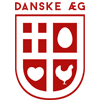What does the Danish Egg-stamp represent?
The Danish Egg-stamp sets a high level of food safety, quality and animal welfare. Each part of the production chain has specific criteria that must be met and are checked annually. The criteria are defined in detail in Danish Egg's code of production.
The flag:
Danish Eggs are of Danish origin and quality. The Danish farmer produces the eggs with care and pride. And you only get eggs from hens bred in Denmark.
The egg:
Danish Eggs are perhaps the safest in the world. The production is subject to one of the world's most stringent control programs, where the chickens, among other things, are tested for all types of salmonella every 14 days throughout the production period. And Danish Eggs can guarantee an unbroken cold chain from farmer to refrigerated counter.
The heart:
Like other eggs, Danish Eggs are exactly as nature has created them. They are rich in protein and contain a wide range of vitamins and minerals, according to analyzes from the DTU – National Food Institute. FAO and WHO describe the protein in eggs as being of high quality because the bioavailability is high.
The hen:
Danish eggs are animal welfare of a high quality. The eggs are produced under sound conditions and with high demands for the well-being and welfare of the hens throughout the production period. Unlike many foreign hens, Danish hens are not beak trimmed.
The industry code – what is it?
As an industry organization, Danish Eggs has drawed up a code of production to produce shell eggs in Denmark. The goal for Danish Eggs is to ensure a production of shell eggs that meet the requirements for high food safety, quality and animal welfare.
The code of productions primary focus is control of salmonella, and it is therefore designed to prevent the introduction of salmonella into the laying flocks and thereby prevent the individual consumer from getting sick from eating Danish eggs. Simultaneously the code of production must ensure a high quality of the product, traceability throughout the production system, as well as maintaining and developing the current applicable regulatory requirements for both animal welfare, environment, approved disinfectants and parasite agents, and also monitoring and control of other infectious poultry diseases.
The code of production for Danish Eggs requires that eggs must come from shell-egg flocks, which comply with both current legislation and the prescribed requirements in the code. It gives the individual actors a tool to develop and implement concepts in the production, that can maintain the necessary efforts to continuously ensure consumers a product with a very high level of food safety.
The code of production covers all stages of the production chain in the process of producing a shell egg, ranging from the delivery of day-old chicks for parent stocks, central breeding, parent-stock production, hatchery conditions, delivery of the day-old chicks, breeding of hens, production of shell eggs, storage of shell eggs at the production site, collection of the shell eggs at the production site as well as some conditions related to the packing plant regarding the collection of the eggs.
The code of production affects the following areas:
Salmonella control program
Traceability for both product, animal and feed
Registration and documentation in all stages of production
Audits in all stages of production
Rules for the production of poultry feed
Product quality
Labeling of the product
Animal welfare requirements
Environmental requirements
Regulatory control
Avian Influenza monitoring
Vaccination strategy
Approved disinfectants

